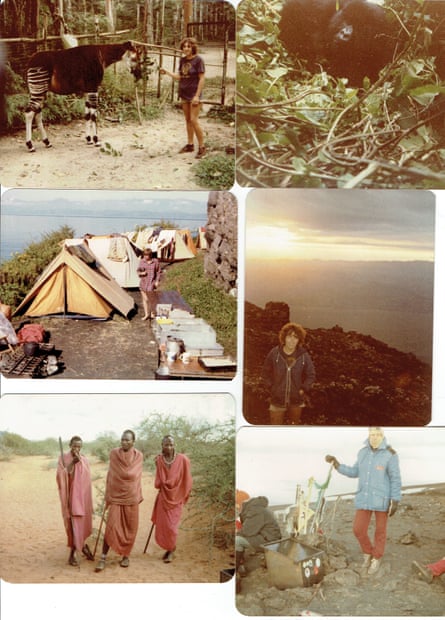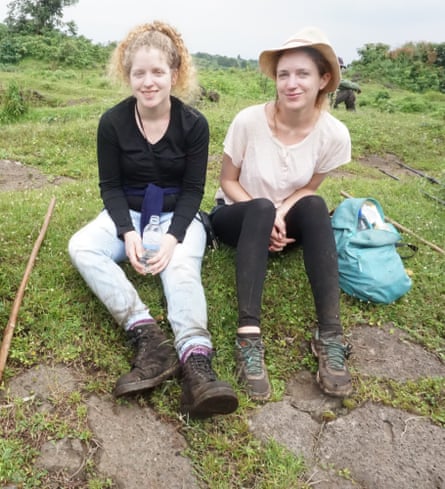[ad_1]
When I told my mum I was taking my younger sister to the Democratic Republic of the Congo, she could barely contain her excitement.
Thirty years before we set foot in Goma, our mother arrived in the same city on a dusty Bedford truck that had carted a swag of lanky youths all the way from London. Back then, the DRC was called Zaire and civil war had yet to tear the region apart. Mum remembers Goma as being quite cosmopolitan.

When my sister and I passed through, there were “no firearms” signs tacked to ATM booths. Virunga national park rangers stuck with us at all times. We weren’t allowed to walk alone. My sister had never travelled outside New Zealand or Europe.
It might seem reckless, visiting a country considered so risky for foreigners. Most travel insurance policies refuse to cover it. But we were dogged in our pursuit of reaching the peak of the Nyiragongo volcano our mother had climbed decades earlier.

I didn’t always plan to retrace my mother’s travels around the world. Yet some quirk of nature or nurture has landed me in many of the same places she journeyed through, back before she was anyone’s mother.
Shrugging in the face of convention, Mum spent the late 70s and early 80s pursuing a series of adventures that became steadily more outlandish. At 20, she worked in Greece as a groom in a stable of Arabian stallions. She lived on a kibbutz in Israel. There she met a man and travelled with him to the United States.
They hitchhiked from a ranch in Wyoming to California, catching rides with young men who had driven three states away from home for the hell of it. They slept under bridges and on beaches and, camped alongside Vietnam vets who were trying to outrun themselves. She drew the line at jumping on to trains.
Eventually, Mum hitchhiked all the way down to the Pacific coast of Mexico. Later, she backpacked solo through Indonesia, guided by a well-thumbed 1982 copy of Lonely Planet Southeast Asia on a Shoestring, which still sits on her bookshelf. She went to New Zealand to hike. She ended up getting married instead.
Mum travelled because of the stories told by her Jamaican born and raised father. She grew up in rural England listening to his memories of custard apples and alligators on a hot and humid island far away.

Similarly, when I was young, I pored over sepia-toned photographs of my mother as a young woman, with a feathery haircut and skimpy shorts, feeding an okapi, standing on top of Kilimanjaro, posing on a volcano.
These stories planted the seed: I wanted to see beyond New Zealand’s small horizons. As soon as I was old enough, I shot off overseas on a one-way ticket. While my peers found jobs, saved for houses and settled into long-term relationships, I emptied my bank account over and over, going wherever I could find a cheap flight, a temporary job, or a new adventure.
after newsletter promotion

Comparing notes with Mum, somewhere along the line I realised my travels echoed hers. It might have been sheer chance, or perhaps an unconscious direction set by her stories. Or maybe it just goes to show the backpacker routes carved out by travel guidebooks have stood the test of time. Whatever it was, I have trodden some of the same paths unintentionally as well as on purpose.
I moved to Tanzania for a job and stood at the foot of Kilimanjaro. I crossed the Serengeti in a dusty safari Jeep.

I made it to Indonesia and sent her a photo of myself, lying among a dozen other bodies prone with sea sickness, on a boat from Lombok to Flores. She flipped through her album and sent back a photo of travellers puddled on a deck, suffering the same affliction on the same route. I washed up on the Pacific coast of Mexico, with a laptop instead of a tent. The small towns along this coast have Starlink now.
Many things have changed since she travelled. I don’t send letters home – I share my location on Instagram and hundreds of people, not just my immediate family, know where I am. Instead of precious rolls of film carefully meted out on special moments, I take endless smartphone photos that will probably never be printed. Hippies have been replaced by digital nomads.
But the lure of travel is as compelling as ever. Where does it end? Her restlessness ran out – mine is still burning. Maybe I’ll stick out my thumb in a foreign country and end up meeting the man I’ll marry, like she did. In the meantime, I’ll keep collecting stories to pass on.
[ad_2]
#didnt #plan #retrace #mothers #travels #footsteps #world
( With inputs from : www.theguardian.com )


